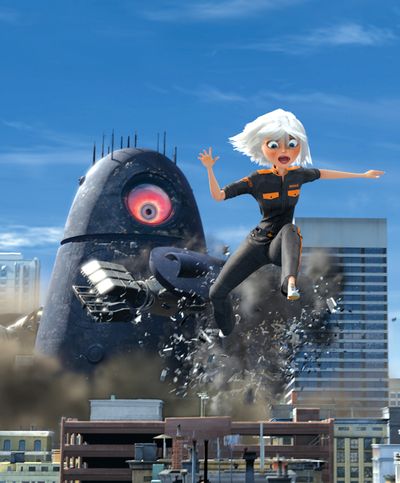2-D vs. 3-D
DreamWorks pushes the limits of technology with its latest film, ‘Monsters vs. Aliens’

“Monsters vs. Aliens” opens with an old 3-D gag: A ball bounces directly into the audience, causing moviegoers to instinctively scoot back in their seats. But the resemblance to old-fashioned 3-D ends there.
The film, in theaters today, relies on entirely new technology – much of it developed during production – to lend depth to an epic battle in outer space, and drama to the collapse of the Golden Gate bridge, as four modern monsters fight to save Earth from alien invasion.
“We can dial in the (3-D) to a degree that was unthinkable even 10 years ago,” said the stereoscopic supervisor at DreamWorks, who legally changed his name 12 years ago to Phil Captain 3D McNally (it appears on his driver’s license as Captain IIID.)
“What I’m hoping people will see in ‘Monsters vs. Aliens’ for the first time is stereoscopic filmmaking that feels completely integrated into the flow of the story.”
Unlike most 3-D movies, which are conceived and shot in two dimensions and then rendered later, “Monsters” was made start to finish in three dimensions, with directors watching daily takes through 3-D glasses.
Producer Lisa Stewart said it made sense for the story, which she characterized as “an homage to the 1950s and ’60s monster horror movies where 3-D really first came into the fore.”
The film follows Susan (voiced by Reese Witherspoon), who’s transformed into the 49-foot-tall Ginormica after she gets hit by a meteor on her wedding day. When aliens attack the planet, it’s up to her and her fellow monsters – a gelatinous blob named B.O.B. (Seth Rogen), a mad scientist called Dr. Cockroach (Hugh Laurie) and a fish-ape known as the Missing Link (Will Arnett) – to save the world.
The characters, concepts and landscapes lent themselves to three-dimensional exploration. But there were concerns about the technology: What were its limitations? Would filmmakers be reduced to a series of coming-right-at-you sight gags?
“There was an initial fear that it was going to be a gimmick like it was in the ’50s, where we’re suddenly going to be asked to throw a bunch of stuff out through the screen,” Stewart said.
“But that was not at all what we wanted to do. … It was about how can we use this (technology) to tell the story that we’re already telling, how can we use it to our advantage.”
They developed the story as they typically would, she said. The magic – and complications – began when they started shooting.
“There was a lot of trial and error at first,” Stewart said. “And there were a lot of preconceived rules of what you could and could not do in 3-D.”
For example, quick cuts during action scenes were thought to be impossible because such drastic perspective changes caused too much eye strain.
“In real life, there’s no such thing as a cut,” noted McNally.
His team solved the problem by creating a tool that digitally blends depth, he said, so “you get the feeling of a fast cut with the comfort of a slow dissolve.”
They developed virtual cameras to allow for more realistic action shots, so when Ginormica skates through the streets of San Francisco on two cars, it feels like a real camera – not a computer – captured the action.
The team also learned to manipulate depth frame by frame, switching seamlessly from 2-D to 3-D to make fast-action scenes easier on the eye.
McNally, who has been doing “stereo photography” for almost two decades, said movie fans have been receptive to 3-D pictures since the ’50s – it’s just that technology kept tripping up the format.
Not anymore: Computer-generated images and digital projectors have advanced enough to make 3-D cinema viable.
Old-fashioned 3-D films relied on two projectors playing simultaneously, one showing a left-eye image and the other a right-eye image, mimicking the brain’s perception of depth through the merging of these separate images.
If the timing or alignment of either projector was off, moviegoers ended up with a blurry picture, eye strain and headaches.
Digital projectors fixed that. A single projector runs at 144 frames per second (instead of the typical movie pace of 24), projecting sequential images for the right eye and left eye so fast that they appear to be simultaneous.
“It literally projects left eye and right eye three times per movie frame,” McNally said, adding that the projectors also allow for “perfect synchronization and perfect alignment” – meaning no more shaky pictures.
The result? Seamless 3-D cinema that studios and filmmakers are betting on for future projects.
Studio chief Jeffrey Katzenberg promised last year that all future DreamWorks Animation releases would be in 3-D, beginning with “Monsters vs. Aliens.” At least a dozen 3-D films are set for release this year, including Pixar’s first 3-D venture, “Up,” and James Cameron’s live-action 3-D epic, “Avatar.”
While ticket sales for 3-D movies, which typically cost a few dollars more, could boost box-office totals, moviegoers may stand to benefit most.
“I think the 3-D is really cool,” actor Rogen said.
“I loved it,” added Kiefer Sutherland, who plays General W.R. Monger, the Army officer in charge of the monsters.“I’m 42 years old, and there’s that one shot where the meteorites are heading toward Earth and they slowly pass over your right shoulder, then slowly over your left shoulder and above your head, and I still looked around to see where they were coming from.”